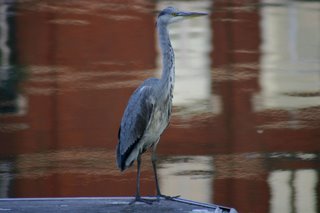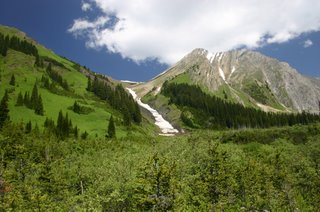
Canadian Hoary Marmots sing a long monotone whistle to let you know they are out and about in the rocks and boulders that are strewn down the steeper slopes at the tops of the valleys in the Rockies. This little marmot was likely about six months old, one of four or five from the winter litter. His first sunshine was likely in April and on this September afternoon, he was soaking up the rays for one of the last times before the family settled into winter hibernation. During the summer Golden Eagles snatch the less wary babies and Grizzlies dig out the burrows in the late summer and fall.
I heard the whistle and spotted two generations sunning on adjacent boulders. The sun was in my face so I decided to circle behind them. "They'll scurry into the rocks," I figured, but hope springs eternal. I moved very slowly, I was carrying about thirty pounds on my back and dancing the boulder ballet as quietly as possible. To my pleasure and amazement the furry little animals continued to sun, seemingly oblivious to my antics. I stopped to take pictures every five meters or so, thinking every shot would be my last, and eventually ended up about ten meters behind and above them. There was no wind, so my scent, if that were an issue, was minimized. I was definitely in what I would expect would be the peripheral vision of those big eyes, but they never turned to me.

Once I had closed in to the ten meter mark I positioned myself with my pack-ladden back against a big chest-high boulder and adjusted my Canon SLR with the Ultrasonic 100 to 300 zoom lens. I adjusted the polarizer. The late afternoon sun was full and hot so I shortened the shutter speed to about 240 and took a few shots. The sun was way too bright to view the images. I bracketed the shots. After about ten shots I decided to move closer. I had really settled into my shooting position, and when I shifted, the sound of my pack scraping off the boulder startled the marmot. I froze. The little critter looked right through me. I don't think they can see very well. I waited a minute and crept slowly to within five meters and took more shots. The next time I moved the little marmot moved to the edge of the rock, and when eventually I moved to within three meters, the animal slipped over the edge and disappeared. As I tried to walk around the boulder, the marmot emerged again and almost ran into me. I climbed below the boulder and found the little marmot settled in the entrance of a burrow, waiting on who knows what. I took more photos, while the trusting little animal meandered around the entrance of the burrow. I can only hope that marmots can recognize a Grizzly from a human, because by the time I took my last shot I was only a meter from his hoary body.


There was a bear warning online for the trail and there were signs at the trailhead. Surrounding the trail for the first few kilometers were layers of Canadian Buffalo Berry bushes basking in the September sunshine. About half a clik up the trail we came upon fresh scat to confirm the presence of the big bear. There was fresh berry scat everywhere, some strewn in tiny droppings that suggested the presence of the three cubs that the notice suggested were feeding with their Mom. Big plops for Mom; little drops for the first year cubs. Three cubs is a large litter for Banff. This meant a healthy Mom, abundant food last year before she went into hibernation, just as much food this year for the cubs, and the absence of a male predator grizzly popping up when Mom was not prepared. We never saw the bears but both that day and two days later when we hiked out, we learned that we had just missed the family on both trips. Other, more fortunate (?) hikers came across the grizzlies just before or after we passed.

Spruce Gourse are either the most timid or the most stupid birds in the Rockies. These birds nonchalantly wander across the path, seemingly oblivious to humans, and unless you move suddenly, jump, or run at them, they just carry on. We came across three families. I followed one family off trail to get a better picture. I circled round a family of four and was happily taking photos when I hear this "whirring sound,"a call I had never heard before. The grouse all ran back towards me, then past me, as if I were only another spruce tree, and sequestered themselves in a group under a bush. Something had spooked them. A coyote, a raptor, a something.

Pileated Woodpeckers work at the base of trees and peck out rectangular holes. This was a fresh site, less than two days old, because I would have seen the sawdust on the way up. The beak-pecked spruce dust was very fresh and evenly distributed at the base of the tree. I'm not sure why, but the bird often pecks out two eyes and either a nose or a long mouth. Always makes me think of Munch's
The Scream. These birds are the biggest woodpeckers in Canada.

Orange is my favorite color in nature. Well, green is great too, but orange is the color of the sun, and green is the color of growth, courtesy of the sun.
I love lichen. I lichen love.
Well, anyway, this was a bit of sunshine in a green forest, on a boulder covered in a kaliedescope of lichen.
Lots of shrooms; lots of panaromas; lots of fun.








 A Grey Heron in Europe, a Great Blue Heron in North America. With slow and deep wingbeats the heron winged over me and circled over the river before landing on the wharf.
A Grey Heron in Europe, a Great Blue Heron in North America. With slow and deep wingbeats the heron winged over me and circled over the river before landing on the wharf. A Coot in Europe and American Coot in North America.
A Coot in Europe and American Coot in North America.  A gaggle of Mute Swans. They were quiet. A man was feeding them along the Main in Frankfurt. The Black-headed Gulls got their share too. There was a solitary female Teal mixed in with the Gulls and Swans.
A gaggle of Mute Swans. They were quiet. A man was feeding them along the Main in Frankfurt. The Black-headed Gulls got their share too. There was a solitary female Teal mixed in with the Gulls and Swans.  Wood Pigeons are the largest in the pigeon family, and compared to the regular-sized pigeon in the lower left, are clearly large. Perhaps four times the volume? Wow! A first.
Wood Pigeons are the largest in the pigeon family, and compared to the regular-sized pigeon in the lower left, are clearly large. Perhaps four times the volume? Wow! A first. Black-headed Gulls are common in Europe. By the coast, along the rivers, and in the cities.
Black-headed Gulls are common in Europe. By the coast, along the rivers, and in the cities.  A Common Gull. But not so common that I had ever identified one before. This was a first.
A Common Gull. But not so common that I had ever identified one before. This was a first.  This Moorhen swam along the wharf in one direction and then hopped onto the wharf and walked back in the opposite direction.
This Moorhen swam along the wharf in one direction and then hopped onto the wharf and walked back in the opposite direction.  I saw two paraqueets in Europe in November. The first in Brussels was in the gardens outside the Royal Palace. I saw the typical bullet flight but thought the sighting of a parrot at that time of the year to be improbable. Then I heard the squawking. I tracked the birds down and patiently waited until they came into view. A Rose-ringed Paraqueet.
I saw two paraqueets in Europe in November. The first in Brussels was in the gardens outside the Royal Palace. I saw the typical bullet flight but thought the sighting of a parrot at that time of the year to be improbable. Then I heard the squawking. I tracked the birds down and patiently waited until they came into view. A Rose-ringed Paraqueet. 














































